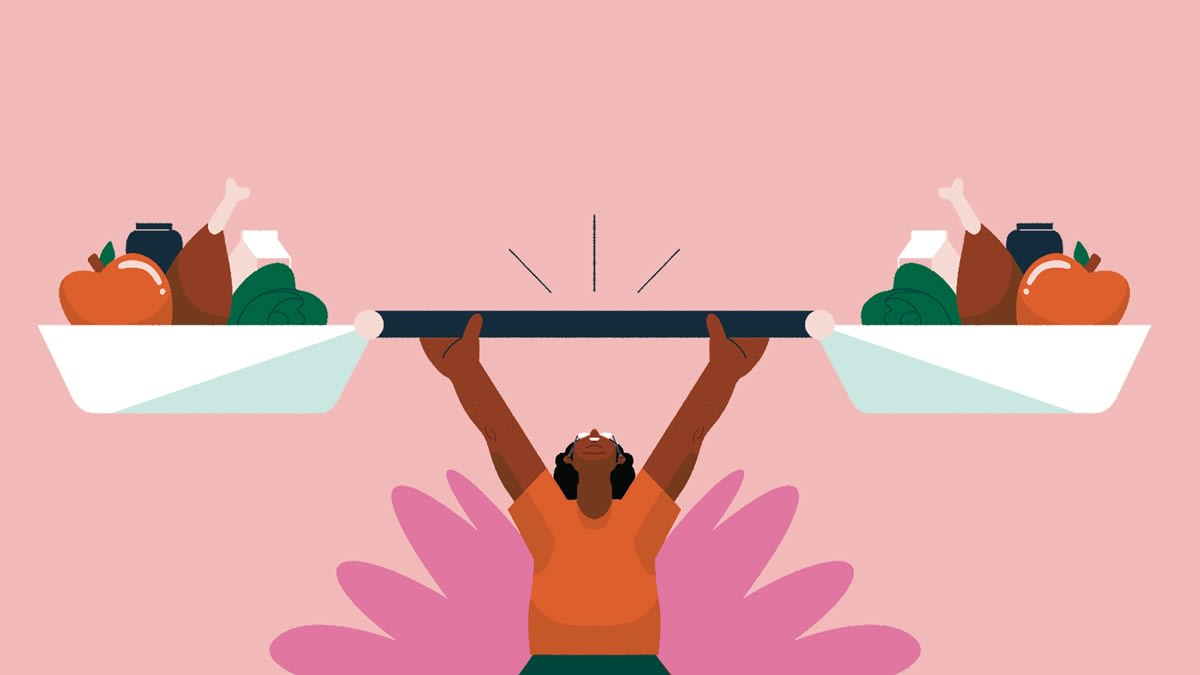What to Eat to Get Stronger

The foods you choose are just as important as exercise
A healthy diet can help you build and maintain muscle.
By Janet Lee
Have you found yourself feeling a little weaker than you used to? Are you having trouble climbing stairs or carrying groceries? The reason may be reduced muscle mass.
With age comes some decline in muscle, and for many people that’s accompanied by a drop in strength and function. Severe muscle loss, known as sarcopenia, can increase the risk of illness and even death.
Although you can’t prevent all age-related muscle loss, you can slow it down significantly and even boost your strength level in the process. You’ve probably heard that exercise, especially weight training, can help you build and maintain muscle. What isn’t discussed as often is the role that diet plays in keeping your muscles in good shape. “You can’t get stronger without eating properly, so diet is essential,” says Elizabeth Klingbeil, RDN, PhD, an assistant professor in the department of nutritional sciences at the University of Texas at Austin.
Follow these eating tips to fuel muscle growth and feel stronger.
Bump Up Your Protein
Protein is core to building muscle and, even more so, maintaining it, Klingbeil says. The National Academy of Sciences recommends that adults eat 0.36 gram of protein per pound of body weight per day. But an analysis of data from the National Health and Nutrition Examination Survey found that 42 percent of men and 50 percent of women over age 70 don’t get that much.
Some experts recommend even more protein for older adults to compensate for muscle loss and the fact that building new muscle becomes harder with age, Klingbeil says. Aim for 0.45 to 0.59 gram per pound per day—that’s 72 to 94 grams for a 160-pound person. (But if you have kidney disease, check with your doctor about your protein intake because too much can tax your kidneys.) Dietitians generally recommend spreading protein throughout the day because that may help your body absorb it better, but Klingbeil says that getting enough is the most important thing.
The source of protein isn’t super-important for building muscle, says Travis Masterson, PhD, the Broadhurst Career Development Professor for the Study of Health Promotion and Disease Prevention at Pennsylvania State University in University Park. Animal foods tend to have more per serving than plant sources. But for other aspects of your health, it’s best to get at least some of your protein from plants, such as beans, nuts, and tofu.
A plant-based diet that includes mostly whole foods is good for your heart and brain, and it lowers your risk of certain cancers. “It also appears to be gentler on the kidneys than a diet high in animal protein as we age,” says Judy Lester, MS, a clinical dietitian at the University of North Carolina Health Care System in Chapel Hill.
There are 20 grams of protein in a cup of tofu; about 18 grams in a cup of lentils, white beans, or edamame; 8 grams in a cup of quinoa or whole-wheat pasta; and 7 grams in an ounce of peanuts. Beef, salmon, and chicken breast have about 24 grams in 3 ounces. A 5.5-ounce serving of plain nonfat Greek yogurt has 16 grams, a cup of low-fat milk has about 9 grams, and an egg has 6 grams.
Get More Calories
“If you’re not getting enough calories, your body will break down muscle,” Klingbeil says. Calorie needs vary based on height, weight, gender, and activity levels, but eating 1,800 to 2,400 calories per day is probably adequate.
Choose Quality Carbs
Carbohydrates fuel your muscles, so they can help you feel stronger. The best sources are whole grains, legumes, fruits, and vegetables. Refined carbs like white bread, crackers, soda, and desserts can boost short-term energy, but unlike high-quality carbs, they don’t have the advantage of being rich in fiber and other nutrients.
Research shows that fiber may help build or preserve muscle mass, possibly because it increases the level of healthy bacteria in the gut that produce short-chain fatty acids. These compounds are involved in muscle development.
Check Your Vitamin D
Some studies show a connection between vitamin D levels and muscle strength, although it’s not clear whether getting more D from your diet or a supplement will help you become stronger. Still, we know that the vitamin is important for bone, muscle, and overall health, Klingbeil says, so getting the recommended 20 micrograms (800 IU) per day is smart. New guidelines from the Endocrine Society don’t recommend regular vitamin D testing for healthy adults, so ask your doctor what’s right for you given your particular health picture.
Add Omega-3s
These fats, found in fish, may help protect against normal age-related declines in muscle. In a 2020 review of research on sarcopenia published in the journal Nutrients, researchers noted that eating fatty fish was linked to increases in muscle mass and better performance on muscle-strength tests. Other studies have shown similar benefits for people who took omega-3 supplements, but the science isn’t conclusive. For now, aim to eat two servings of fatty fish like salmon or sardines per week, which is the American Heart Association’s recommendation for heart health.
Stay Hydrated
Getting plenty of fluids is important for overall health and preserving muscle, Lester says. Muscle is 70 to 75 percent water, and insufficient water content inside muscle cells has been linked to changes in muscle strength and the ability to do daily activities, as well as a higher risk of frailty in older adults. Drinking water is obviously helpful, but you can also get fluids from other healthy beverages (coffee, tea, and milk, for instance) and eating fruits, vegetables, and soup.
Ask Your Doc About Creatine Supplements
This compound in muscle tissue is found in meat and seafood, and your body also makes it. But taking it in pill or powder form may be helpful for some people. “Creatine in the muscle is used for producing energy, especially in that initial onset of a contraction, the first 1 to 2 seconds,” Masterson says. “The more creatine you can get into the muscle, the more effective that first bit of contraction is going to be.”
Creatine is often used by athletes looking to improve exercise performance, but some research suggests that older adults may benefit from it, too. A review published in 2019 in the Journal of Clinical Medicine found that creatine—in combination with regular strength training—may help reduce the risk of sarcopenia and falls. (Muscle is important for balance, too.)
“I’m pretty anti-supplement overall,” Masterson says. “But creatine is one where there are no known side effects and it’s pretty cheap. Will it drastically change someone? No, but it could give you more energy for exercise or even provide more oomph as you’re trying to get out of a chair.”
The Importance of Strength Training
There’s no getting around the fact that exercise is crucial for your muscles. But that doesn’t mean you have to take up bodybuilding to get stronger in your 60s, 70s, and beyond. Activities like walking and simple strength-training moves such as chair squats (repeatedly sitting and standing) and wall pushups—and just being active and moving more in general—are a good way to preserve muscle and keep bones and joints strong, Masterson says.
If you want to go further, you can find weight-focused classes that use dumbbells or other simple equipment at gyms or community recreation centers, or online. (Check out the workout videos from the National Institute on Aging. ) Try to time your workouts so that you’ll be having a meal or snack within a few hours afterward, Masterson says. Both exercise and eating protein stimulate muscle development, so combining them will lead to greater effects.
Editor’s Note: This article also appeared in the February 2025 issue of Consumer Reports On Health.
Consumer Reports is an independent, nonprofit organization that works side by side with consumers to create a fairer, safer, and healthier world. CR does not endorse products or services, and does not accept advertising. Copyright © 2025, Consumer Reports, Inc.
Source link







